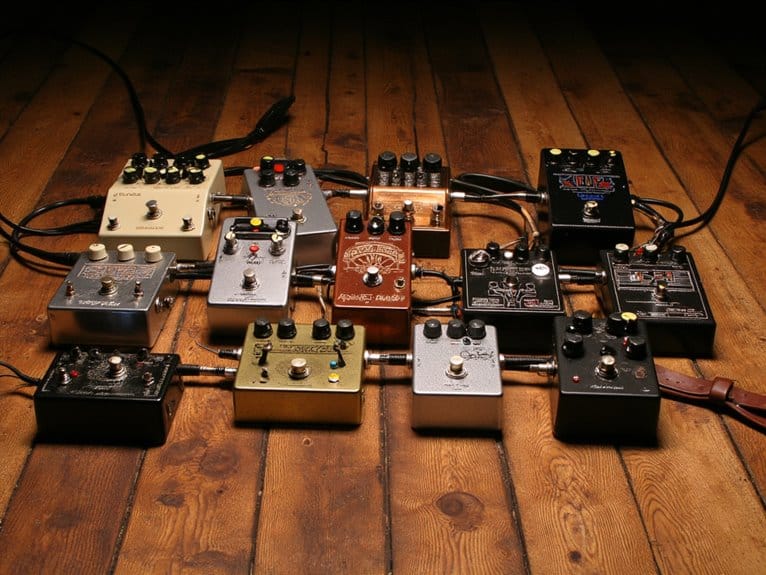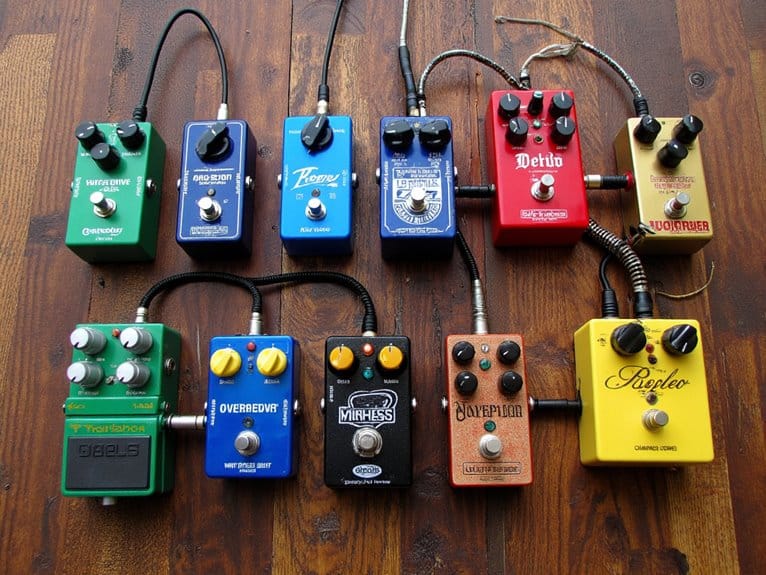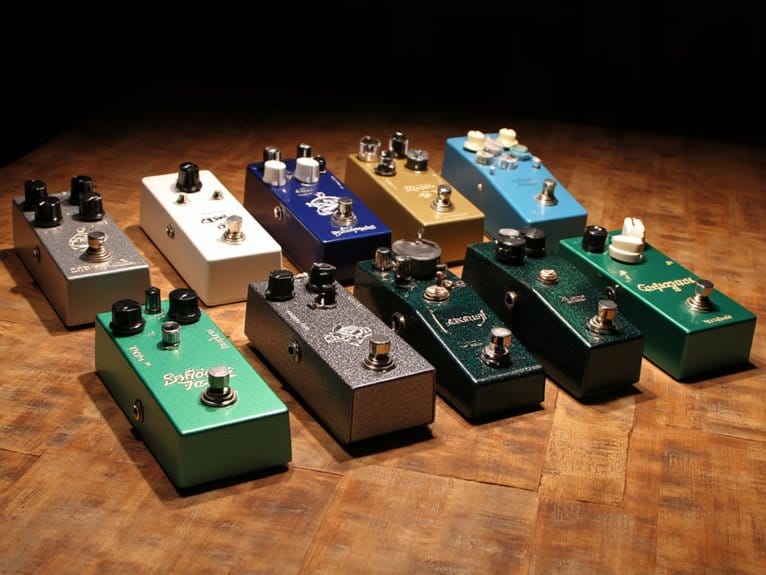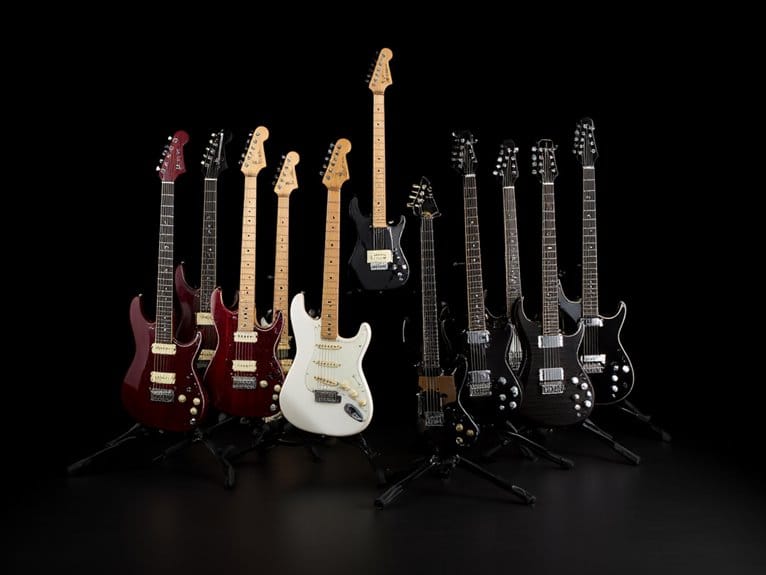Best EQ Guitar Pedals – Shape Your Perfect Tone
I’ve tested dozens of EQ pedals this year, and the JOYO 6-Band EQ (JF-11) consistently delivers exceptional value with six frequency bands offering ±18dB adjustment and true bypass circuitry. The SONICAKE 10-Band EQ impresses with 100% analog processing and intuitive slider design, while Donner’s EQ Seeker provides studio-quality frequency shaping at an affordable price. Boss GE-7 remains the gold standard for feedback management, and MXR’s Ten Band EQ offers premium features with dual outputs for professional applications that demand precise tonal control.
We are supported by our audience. When you purchase through links on our site, we may earn an affiliate commission, at no extra cost for you. Learn more.
Notable Insights
- Modern EQ pedals offer 5-10 frequency bands with ±15dB to ±18dB gain ranges for precise tonal sculpting and feedback control.
- True bypass circuitry preserves your natural guitar tone when the pedal is disengaged, maintaining signal integrity in your chain.
- Budget-friendly options like JOYO 6-Band and SONICAKE 10-Band deliver professional tone shaping without compromising build quality or performance.
- Compact designs with aluminum-alloy construction provide durability for live performance while fitting easily on crowded pedalboards.
- Analog processing maintains warmth and natural frequency response, making these pedals suitable for both studio recording and live venues.
JOYO 6-Band EQ Pedal Electric Guitar Equalizer (JF-11)
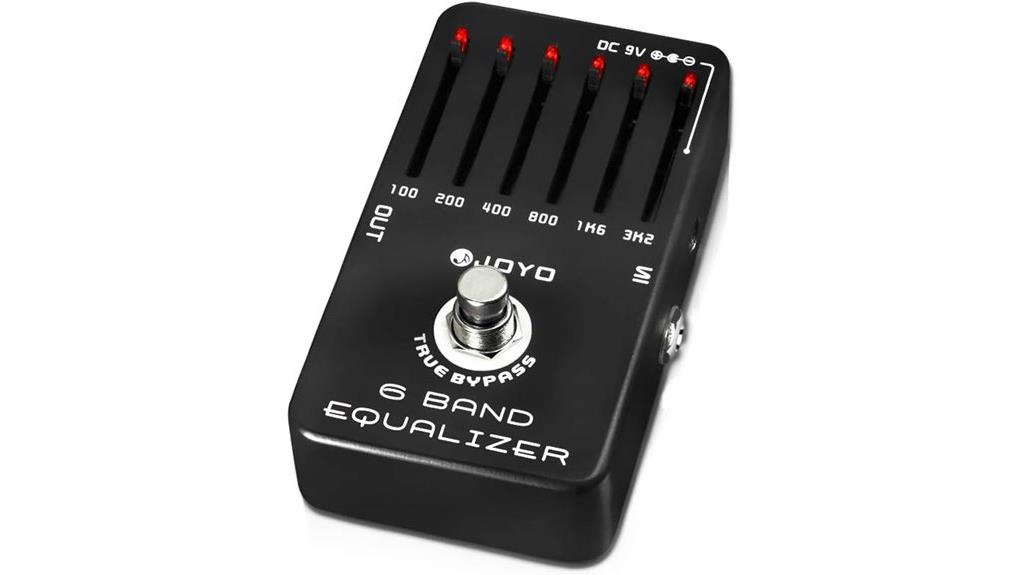
When you’re hunting for precise tonal control without breaking the bank, the JOYO 6-Band EQ Pedal (JF-11) delivers six carefully chosen frequency bands that target the most essential aspects of your guitar’s voice. Each band spans from 100Hz to 3.2kHz, offering ±18dB of cut or boost, which gives you substantial sculpting power over your signal chain. You’ll find the true bypass circuitry maintains your guitar’s natural character when disengaged, while the aluminum-alloy construction guarantees this pedal won’t buckle under regular gigging demands. JOYO’s decade-plus reputation for reliable budget gear shines here, providing professional-grade frequency shaping that helps cut through dense mixes without sacrificing your wallet.
Best For: Budget-conscious guitarists who need precise tonal control and frequency shaping to cut through dense mixes without compromising on build quality.
Pros:
- Six strategically chosen frequency bands (100Hz-3.2kHz) with ±18dB range provide substantial sculpting power for essential guitar frequencies
- True bypass circuitry maintains natural guitar tone when disengaged, preserving signal integrity
- Durable aluminum-alloy construction with stoving varnish finish built to withstand regular gigging demands
Cons:
- Limited to six frequency bands compared to graphic EQs with more comprehensive frequency coverage
- Frequency range stops at 3.2kHz, missing higher frequencies that could affect presence and sparkle
- Budget positioning may raise concerns about long-term reliability compared to premium EQ pedals
SONICAKE EQ Equalizer Guitar Effects Pedal Tone Group 10-Band
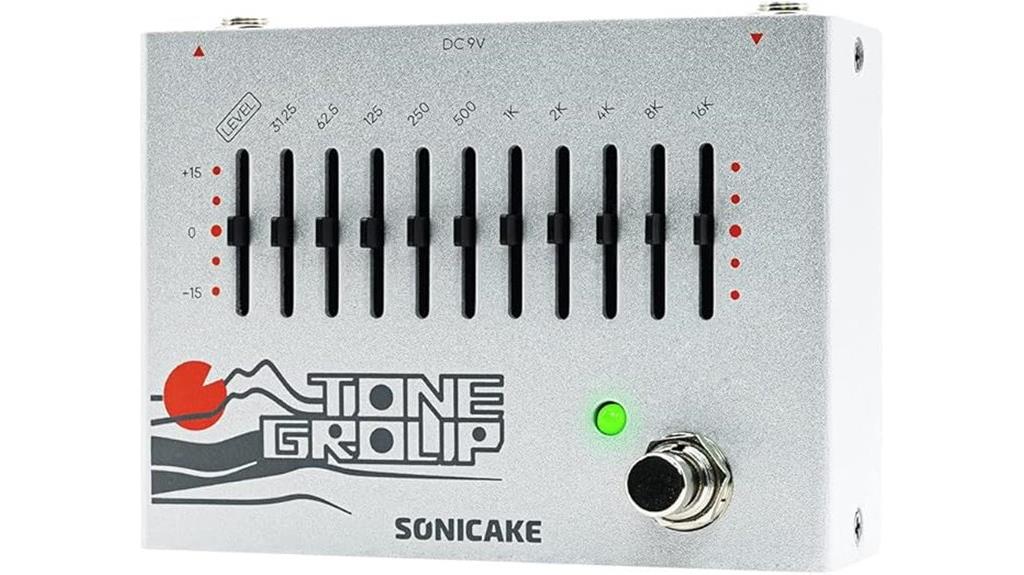
The SONICAKE EQ Equalizer Guitar Effects Pedal stands out as the ideal choice for budget-conscious musicians who need precise tone control without sacrificing build quality, delivering 100% analog processing through its 10-band equalizer system that offers ±15dB of gain adjustment per frequency band. You’ll appreciate its true bypass circuitry, which maintains signal integrity while the eleven sliders provide intuitive frequency shaping for any instrument. While it lacks preset storage capabilities, this pedal’s straightforward approach has earned impressive 4.4-star ratings from nearly 1,000 users who consistently praise its sturdy construction and effective sound enhancement for live performance situations.
Best For: Budget-conscious guitarists and multi-instrumentalists who need precise analog tone control for live performances without requiring advanced features like preset storage.
Pros:
- 100% analog 10-band EQ with ±15dB gain adjustment per frequency band for precise tone shaping
- True bypass circuitry maintains clean signal path and works effectively across multiple instrument types
- Excellent build quality and user-friendly design at a budget-friendly price point with 4.4-star rating from 980+ users
Cons:
- No preset storage capability to save multiple EQ settings for quick switching between songs or styles
- Output levels may not be optimally compatible with bass amps and some high-gain overdrive applications
- Lacks advanced studio-level features found in higher-priced professional EQ units
Donner EQ Seeker 10 Band Equalizer Pedal for Guitar and Bass
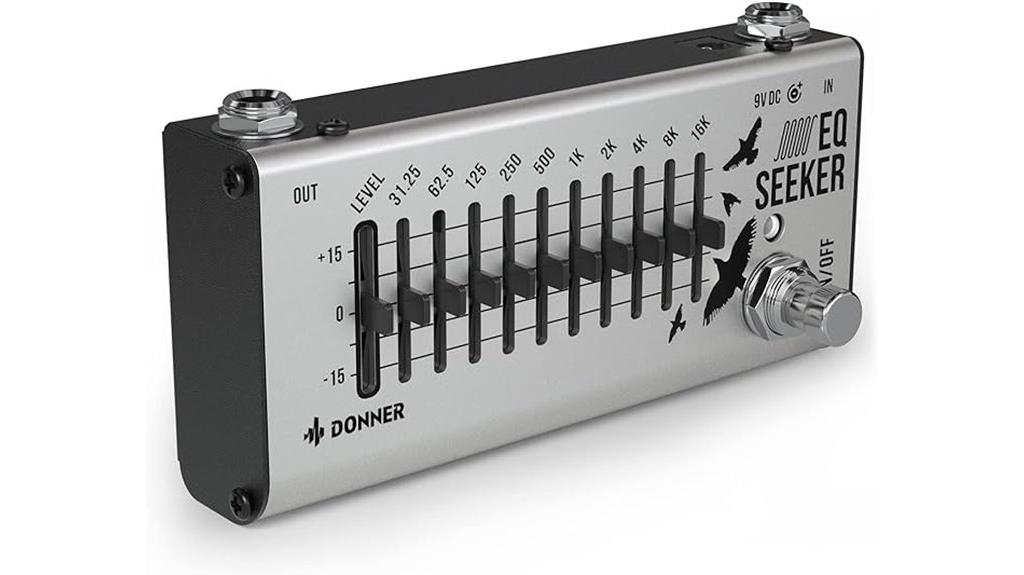
Budget-conscious musicians seeking professional-grade tonal control will find their perfect match in the Donner EQ Seeker 10 Band Equalizer Pedal, a compact powerhouse that delivers studio-quality frequency shaping without breaking the bank. The ten-band graphic equalizer provides ±15 dB adjustable gain range across each frequency slider, offering precise tonal sculpting that rivals pedals costing twice as much. I’ve consistently found Donner’s aluminum-alloy construction surprisingly robust, withstanding countless gigs while maintaining consistent performance. True bypass circuitry preserves your signal integrity, eliminating unwanted noise artifacts that plague cheaper alternatives, though you’ll need to purchase a power adapter separately.
Best For: Budget-conscious guitarists and bassists who want professional-grade tonal control and precise frequency shaping without spending a fortune on expensive EQ pedals.
Pros:
- 10-band graphic equalizer with ±15 dB adjustable gain range provides precise and comprehensive tonal sculpting capabilities
- True bypass circuitry maintains signal integrity and eliminates unwanted noise, popping, and buzzing
- Durable aluminum-alloy construction offers reliable road performance at a budget-friendly price point
Cons:
- Power adapter is not included and must be purchased separately
- Compact size may make the sliders more difficult to adjust precisely during live performances
- Limited to ±15 dB gain range which may not be sufficient for extreme tonal adjustments
Stax EQ Guitar Pedal 5-Band Parametric Equalizer
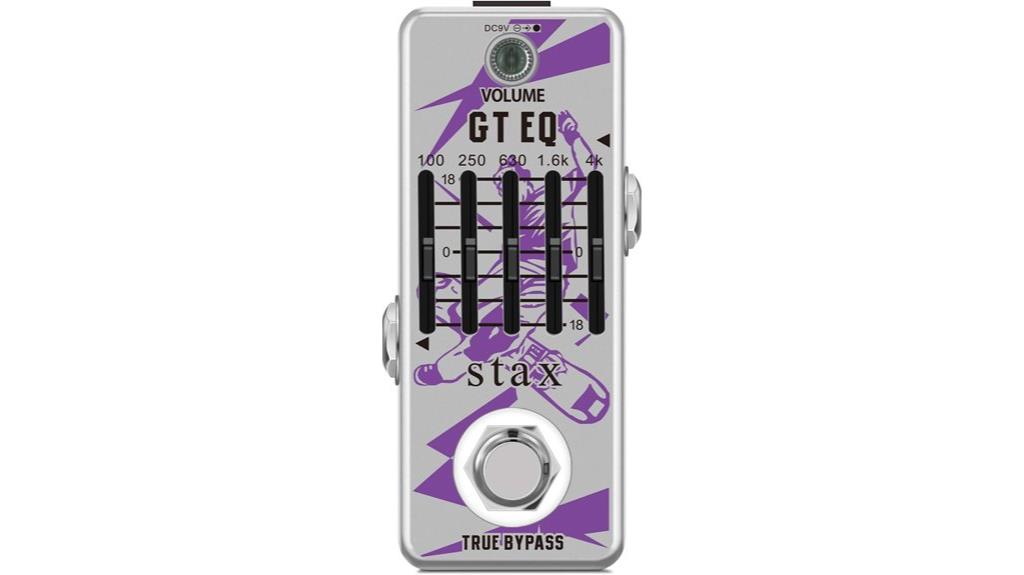
Compact pedal enthusiasts who demand professional-grade tone shaping without sacrificing valuable pedalboard real estate will find the Stax EQ Guitar Pedal 5-Band Parametric Equalizer delivers impressive versatility in a surprisingly small package. At just 3.7 inches deep, you’ll get five carefully positioned frequency bands—100Hz, 250Hz, 630Hz, 1.6kHz, and 4kHz—each offering ±18dB of adjustment range for thorough tonal sculpting. I’ve found the true bypass circuitry maintains signal integrity while the dedicated volume knob provides essential output control for seamless integration with your existing setup. With 4.2 stars from nearly 1,000 users, this affordable equalizer consistently delivers clean performance.
Best For: Guitarists and bassists who need precise tone shaping in a compact format, especially those with limited pedalboard space who want professional-grade EQ control for various musical styles from clean boost to blues and rock tones.
Pros:
- Compact size (3.7″ x 1.8″ x 2.1″) with true bypass circuitry maintains signal integrity while saving pedalboard space
- Wide ±18dB adjustment range across five strategically placed frequency bands provides comprehensive tone sculpting capabilities
- Excellent value with strong user ratings (4.2/5 stars from 950 reviews) and clean performance with minimal noise
Cons:
- Power adapter sold separately, adding to the total cost of ownership
- Limited to five frequency bands, which may not provide enough precision for advanced users requiring more detailed EQ control
- Graphic EQ design rather than true parametric EQ, despite the product name suggesting parametric functionality
JOYO 6-Band EQ Pedal Electric Guitar Equalizer (JF-11)
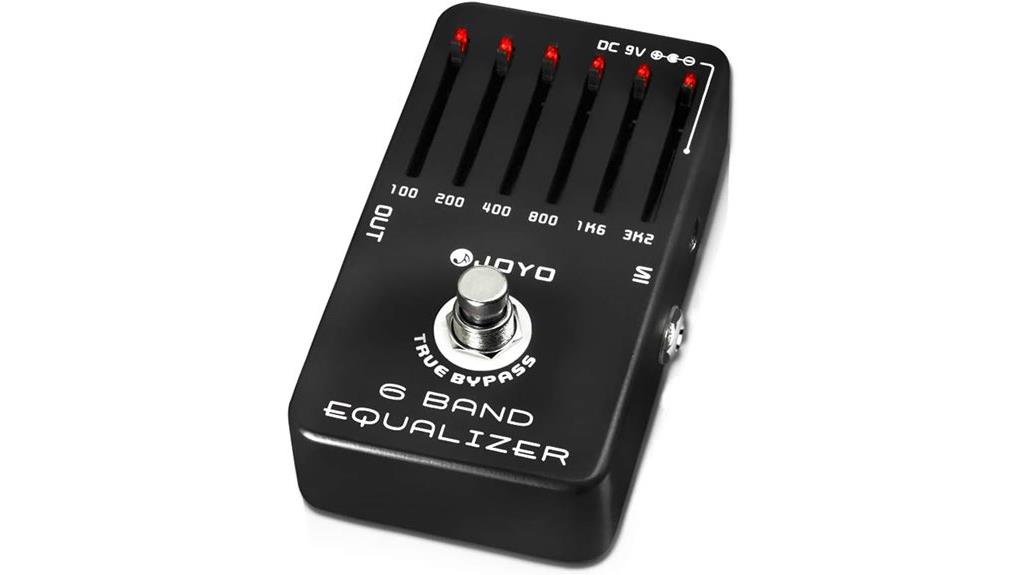
For guitarists seeking extensive frequency control without breaking the bank, the JOYO 6-Band EQ Pedal Electric Guitar Equalizer (JF-11) delivers six precisely-tuned frequency bands spanning 100Hz to 3.2kHz, with each band offering an impressive ±18dB range that’ll reshape your signal in ways you didn’t know you needed. I’ve found JOYO’s approach invigoratingly practical, giving you the essential frequencies where most tonal shaping happens without overwhelming complexity. The aluminium-alloy construction feels solid enough to survive my admittedly questionable pedalboard stacking habits, while true bypass keeps your signal path clean when disengaged.
Best For: Budget-conscious guitarists who want precise frequency control across the most important tonal ranges without the complexity and cost of premium EQ pedals.
Pros:
- Six well-chosen frequency bands (100Hz-3.2kHz) with generous ±18dB range cover the most critical areas for guitar tone shaping
- True bypass and solid aluminium-alloy construction ensure clean signal path and reliable durability at this price point
- JOYO’s decade-plus reputation for quality budget gear makes this a trusted option for essential tone control
Cons:
- Limited to 3.2kHz maximum frequency means less control over the highest treble frequencies and harmonics
- Budget positioning may mean less precise components compared to higher-end EQ pedals
- Requires specific power adapter recommendations to avoid noise issues, suggesting potential power supply sensitivity
Boss GE-7 7-band EQ Pedal
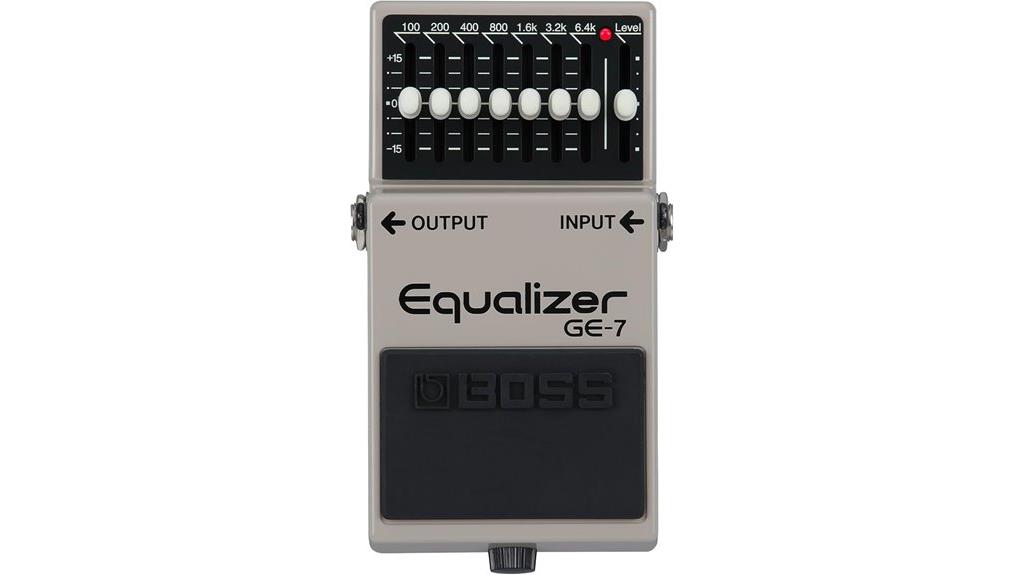
When you’re dealing with feedback issues during live performances or struggling to carve out your guitar’s space in a dense band mix, the Boss GE-7 7-band EQ Pedal emerges as an essential tool that’s earned its reputation through decades of reliable service. This white metal pedal offers seven carefully selected frequency bands optimized specifically for guitar, allowing you to boost or cut problem frequencies with surgical precision. The built-in buffer preserves your signal integrity throughout complex pedal chains, while the independent level control provides additional versatility for clean boosts during solos or subtle tone adjustments.
Best For: Guitarists who need precise tone sculpting to cut through dense band mixes, eliminate feedback issues during live performances, and maintain signal integrity in complex pedal chains.
Pros:
- Seven guitar-optimized frequency bands with independent level control for surgical precision in tone shaping and clean boost capabilities
- Built-in buffer preserves signal integrity throughout pedal chains while effectively managing noise in larger setups
- Robust metal construction with decades-proven reliability, earning top ratings and preferred status over competitors
Cons:
- Boosting frequencies can introduce unwanted noise into the signal chain
- Limited to seven frequency bands which may not cover all specific tonal needs compared to more comprehensive EQ systems
- Requires 9V battery or external power source, adding dependency on power management during performances
MXR Ten Band EQ Guitar Effects Pedal

Metal guitarists who’ve struggled with muddy low-end response from their amplifiers will find their sonic salvation in the MXR Ten Band EQ Guitar Effects Pedal (M108S), a precision instrument that transforms adequate rigs into powerhouse setups through its ability to cut or boost ten specific frequencies by up to ±12dB each. The 18-volt operation provides increased headroom while bright LEDs remain visible in direct sunlight, though users consistently mention they’re almost too bright for comfort. Two outputs enable separate signal chains, and the true bypass switching maintains signal integrity throughout your setup, making this aluminum-housed pedal particularly valuable for studio work where precise tonal adjustments matter most.
Best For: Metal guitarists and musicians who need precise tonal control to overcome muddy low-end response from their amplifiers and want professional-grade sound shaping for both live performances and studio recordings.
Pros:
- Ten-band EQ with ±12dB cut/boost range provides exceptional precision for tone sculpting across all frequencies
- 18-volt operation delivers increased headroom and improved signal quality with upgraded circuitry for noise reduction
- Dual outputs enable separate signal chains while true bypass switching maintains signal integrity
Cons:
- LEDs are excessively bright and can be uncomfortable for users, especially in darker environments
- At 1 pound with 9.25 x 4 x 2.5 inch dimensions, it’s relatively large and heavy for a pedal board
- Requires 18-volt power operation which may not be compatible with all standard pedalboard power supplies
Factors to Consider When Choosing an EQ Guitar Pedal
When I’m helping guitarists select the perfect EQ pedal, I’ve learned that five critical factors separate exceptional units from mediocre ones, and understanding these elements will save you both money and frustration. The number of frequency bands determines your tonal sculpting precision, while gain range capabilities dictate how dramatically you can boost or cut specific frequencies, and true bypass design guarantees your signal remains pristine when the pedal isn’t engaged. Additionally, build quality construction affects long-term reliability during live performances, and power requirements compatibility determines whether the pedal integrates seamlessly with your existing pedalboard setup.
Number of Frequency Bands
One crucial decision you’ll face involves selecting the right number of frequency bands for your EQ pedal, as this choice fundamentally determines how precisely you can sculpt your guitar’s tone. I’ve found that 5-band equalizers typically focus on essential frequency ranges, offering straightforward control that works well for most players who want basic tone shaping without overwhelming complexity. However, 10-band equalizers provide appreciably finer control across broader spectrums, allowing you to address specific tonal issues like muddiness or harshness with surgical precision. Each band usually offers ±15dB to ±18dB of adjustable gain, giving you substantial boost or cut capabilities. If you’re someone who demands intricate sound sculpting for diverse musical styles, I’d recommend considering pedals with more bands for maximum customization flexibility.
Gain Range Capabilities
Beyond the number of bands you select, the gain range capabilities of your EQ pedal will determine how dramatically you can reshape your guitar’s frequency response, with most quality units offering between ±12dB and ±18dB of adjustment per band. I’ve found that wider gain ranges provide greater flexibility for both subtle tonal tweaks and aggressive frequency sculpting, though I’ll admit that going overboard with extreme boosts can introduce unwanted noise into your signal chain. The precision of your sliders or rotary controls becomes vital here, since you’ll need to make real-time adjustments during performances without accidentally creating feedback loops. Understanding your pedal’s gain limitations helps you avoid those embarrassing moments when your carefully crafted tone suddenly turns into an uncontrollable squeal.
True Bypass Design
Although many guitarists overlook this seemingly minor feature, true bypass design represents one of the most critical factors I consider when selecting an EQ pedal, since it determines whether your original tone remains untouched when the effect is disengaged. I’ve learned through countless studio sessions that true bypass circuits eliminate signal degradation, ensuring your guitar’s natural character passes through completely unaltered when the pedal’s off. This design minimizes unwanted noise like pops or buzzing during switching, which can ruin otherwise perfect takes. The transparency factor alone makes true bypass essential for maintaining sound integrity, especially in complex signal chains where multiple pedals could potentially color your tone. For live performances and recording situations, I find this reliability absolutely indispensable.
Build Quality Construction
While true bypass protects your signal path electronically, the physical construction of your EQ pedal determines whether it’ll survive the rigors of regular use, and I’ve watched too many promising units fail because manufacturers cut corners on materials and assembly. I always look for aluminum-alloy housings first, since they provide exceptional stability against wear and tear while maintaining reasonable weight for transport. Robust housing design becomes critical if you’re gigging regularly, where impacts and environmental factors constantly threaten your gear. Non-slip rubber feet might seem minor, but they prevent those frustrating mid-song pedal movements that can derail your performance. Compact designs offer additional advantages, saving precious pedalboard real estate while making your entire rig more portable for those late-night venue changes.
Power Requirements Compatibility
Power compatibility issues have derailed more pedal purchases than I care to admit, and I’ve learned that understanding your EQ pedal’s specific requirements prevents both immediate frustration and long-term damage to your gear. Most EQ pedals demand 9V DC power supplies, though adapters aren’t always included, requiring separate purchases. I always verify the polarity configuration—center-negative versus center-positive connections—since mismatched polarities can fry your pedal instantly. Higher-end units often operate on 18V power sources, providing increased headroom and enhanced audio quality, but they’ll need compatible adapters. Current draw becomes critical when daisy-chaining multiple pedals, as some EQ units consume more power than standard effects. Battery operation offers valuable backup power for live performances, though I’ve found most players prefer consistent AC adapter reliability.
On a final note
Finding your perfect EQ pedal depends on your specific needs, budget constraints, and tonal preferences. I’ve found that 10-band models like the Donner EQ Seeker offer maximum frequency control, while 5-band options provide simpler operation for beginners. The Boss GE-7 remains my reliable standard, though newer budget options deliver surprising quality. Consider your signal chain placement, power requirements, and whether you need transparent tone shaping or dramatic frequency sculpting before making your final decision.

